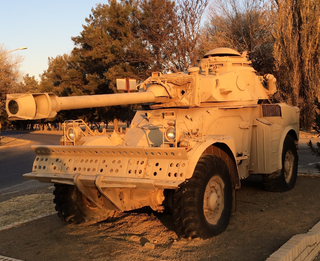Eland Mk7
| Eland Mk7 | |
|---|---|

Reumech Eland at the Tempe School of Armour, Bloemfontein
|
|
| Type | Armoured Car |
| Place of origin | South Africa |
| Service history | |
| In service |
1962 – 1994 (South Africa) 1967 - (other) |
| Used by | See Operators |
| Wars |
Angolan Civil War Rhodesian Bush War 1981 Entumbane Uprising South African Border War Western Sahara War Second Congo War Chadian Civil War Northern Mali conflict Boko Haram insurgency |
| Production history | |
| Designer | Sandock-Austral |
| Designed | 1962 |
| Manufacturer |
Sandock-Austral Reumech OMC |
| Produced | 1964 – 1986 |
| Number built | 1,600 |
| Variants | See Variants |
| Specifications | |
| Weight | 6 tonnes (6.6 short tons; 5.9 long tons) |
| Length | 5.12 m (16 ft 10 in) |
| length | 4.04 m (13 ft 3 in) (hull) |
| Width | 2.01 m (6 ft 7 in) |
| Height | 2.5 m (8 ft 2 in) |
| Crew | 3 (commander, driver, gunner) |
|
|
|
|
Main
armament |
90mm Denel GT-2 (29 rounds) 60mm K1 mortar (56 rounds) |
|
Secondary
armament |
2x 7.62mm M1919 Browning machine guns (2400 - 3800 rounds) |
| Engine | General Motors 2.5 l (150 in3) inline 4-cylinder water-cooled petrol |
| Transmission | 6-speed manual constant mesh |
| Suspension | Independent 4X4; active trailing arms |
| Ground clearance | 380 mm |
| Fuel capacity | 142 litres |
|
Operational
range |
450 km |
| Speed | 100 km/h |
|
|
1962 – 1994 (South Africa)
The Eland is an air portable light armoured car based on the Panhard AML. Designed and built by South Africa for long-range reconnaissance, it mounts either a 60mm (2.4 in) breech-loading mortar or a Denel 90mm (3.5 in) gun on a very compact chassis. Although lightly armoured, the vehicle's permanent 4X4 drive makes it faster over flat terrain than many tanks.
Eland was developed for the South African Defence Force (SADF) in South Africa's first major arms programme since World War II, with prototypes completed in 1963. By 1991, 1,600 examples had been built for home and export; prominent foreign operators included Morocco and Zimbabwe. Local overhauls incorporating lessons from internal operations have resulted in a vehicle capable of withstanding the unforgiving Southern African environment and highly mobile operational style of the SADF.
For many years the standard armoured car of the South African Defence Force was the Daimler Ferret, which was developed in the late 1940s and armed with a single general-purpose machine gun. By the mid 1960s, Ferret spares were becoming difficult to obtain, and its armament was obviously less than adequate. In 1961, South Africa accordingly secured a similar platform with a much wider range of armament installations: the French Panhard AML. That July a South African military delegation headed by Minister of Defence Jacobus Johannes Fouché and Commandant-General Pieter Grobbelaar, chief of the SADF, went to France to negotiate a licensing agreement with Panhard. One hundred AMLs were purchased, presumably for preliminary evaluation purposes, as well as enough turrets, engines, and other associated parts for the later assembly of another 800 in South Africa. Panhard also approved a licence for domestic production of the AML chassis in South African plants. A separate licence was obtained from the French government's Direction technique des armements terrestres (DTAT) between 1964 and 1965 for the manufacture of the AML turrets and armament. The result was the VA (Vehicle A) Mk2, first offered to the SADF's armoured car regiments and reconnaissance commands in 1964. Bids were accepted from four local companies for the manufacture of 300 AMLs with working armament, along with another 150 turretless demonstrators; this contract was claimed by Sandock-Austral, now Land Systems OMC. The production lines were set up with technical assistance from Henschel, an engineering firm based in the Federal Republic of Germany.
...
Wikipedia
